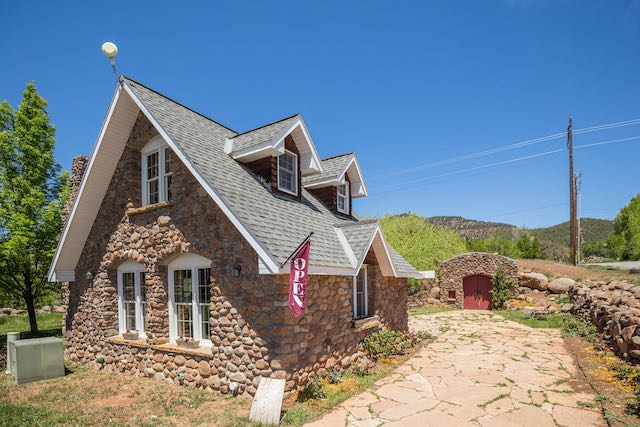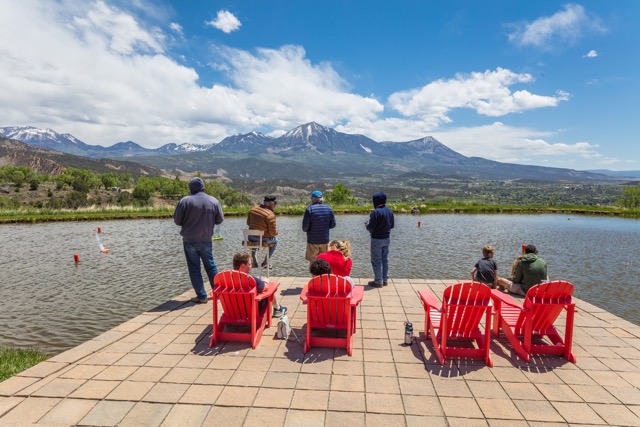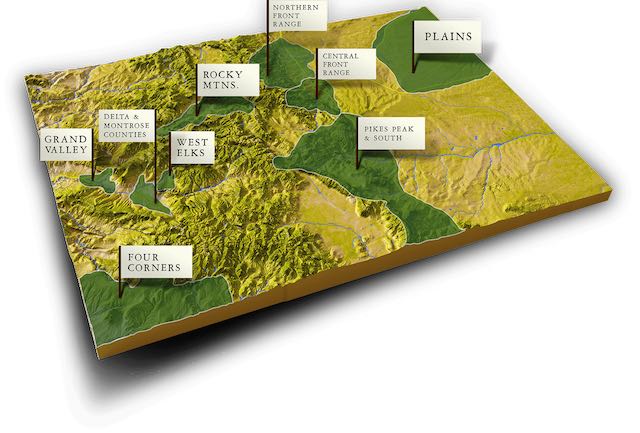Colorado
Wine
Characteristics
It should be no surprise that the Rocky Mountains have the strongest influence on Colorado wine and viticulture. They are truly where the East meets the West, with a dynamic convergence of high plains, mountains, and desert.
The resulting topographical, geographical, and climatological attributes from this convergence produce unique characteristics only found in Colorado: the highest mean altitude of all 50 states at 6,800 feet; approximately three-quarters of the land area in the Continental U.S. above 10,000 feet; 59 peaks over 14,000 feet and 830 between 11,000 to 14,000; the world’s deepest hot springs at 1,002 feet; over 300 days of sunshine annually; and the three valleys of San Luis, Fraser, and Gunnison who commonly record on various winter calendar dates as the coldest in the nation.
On all the broad extent of these United States, certainly, no region can be found which presents more facts of interest, more opportunities for investigation, and greater possibilities than the State of Colorado
– Samuel F. Emmons –
geologist on the King Survey of the 40th Parallel from California to Colorado from 1867 to 1872.
Samuel Emmons may have been speaking to geological opportunities and possibilities. Still, the same sentiment drove early western Colorado farmers to take advantage of two microclimates found along the Colorado and North Fork Gunnison rivers. Both areas were well suited for growing fruit and produce, including grapes. Because consistent precipitation was lacking for the semi-arid climate, irrigation ditches were built, and many remain in use today.
In more recent times, both areas gave birth to two American Viticultural Areas (AVAs), the Grand Valley in 1991 and the West Elks in 2001.
American Viticultural Areas (AVAs)
The Grand Valley and West Elks AVAs are among the highest in the world, growing grapes between 4,000 and 6,700 feet. Grand Valley is adjacent to the world’s largest flattop mountain, Grand Mesa. West Elks is the highest-elevation appellation in the northern hemisphere, ranging between 5,500 to 6,700 feet. Dampening what might in many climes hamper viticulture, the Rocky Mountains to the east of the AVAs can protect from the more severe impacts of Canadian winter arctic blasts experienced by the plains, northern, and central mountains. Their locations in river valleys also benefit from prevailing down-river air movement, which has warming effects in the winter and cooling effects in summer.
Grand Valley is the warmer and larger of the two AVAs, 118 vs 75 square miles. Its season begins a few weeks earlier and enjoys 30 percent more frost-free days. The warmer climate in the Grand Valley is due to the high Book Cliffs along the valley’s northern side radiating heat across the eastern portion of the AVA, coupled with its lower elevation ranging from 4,000 to 4,500 feet. Grand Valley has a more significant percentage of vineyard acres and produces three times more wine than West Elks, 190,291 vs 60,289 gallons (2021/2022).
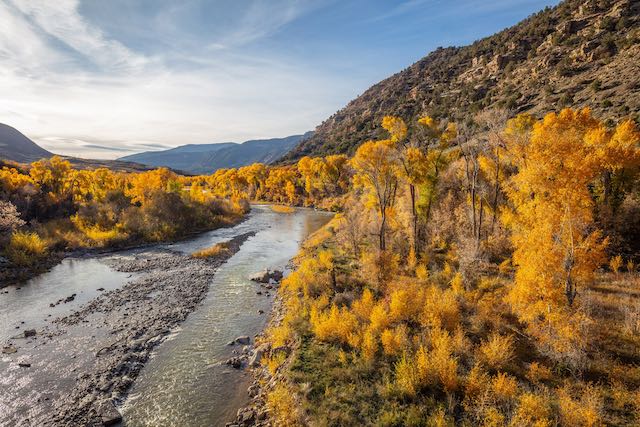
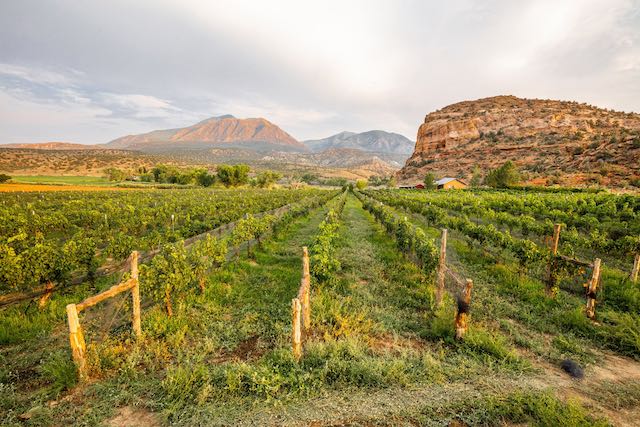
Grape Varietals and Climate Challenges
Given the unique high-altitude characteristics, you may also be surprised to learn the primary grapes grown in Colorado’s AVAs are Vitis vinifera, grape varietals responsible for the world’s great wines. Vitis vinifera grows best in milder temperate climates such as the Mediterranean, which is common to Europe, the U.S. west coast, and elsewhere. The Grand Valley does well with grapes benefiting from longer and warmer seasons, such as Cabernet, Cabernet Franc, Merlot, Syrah, and others; The West Elks focuses on cooler climate grapes such as Riesling, Gewürztraminer, Pinot Noir, and Pinot Gris. One benefit of Colorado’s high-altitude grown wine share in common is a large diurnal shift, the difference between average daytime and nighttime temperatures as in warm days and cool nights. High-altitude solar radiation during the day increases sugar and phenolic ripeness. Still, the process is halted during cool nights, facilitating the retention of acid, which is critical to making well-balanced wine.
The challenge in growing grapes in Colorado at higher altitudes is temperature fluctuations and weather extremes, especially in the spring and fall, where frosts and freezes can make or break a vintage. One extreme weather instance in late October 2020 in what otherwise had been a mild fall involved a significant temperature drop into the teens and upper single digits over two nights. The intense and early arctic blast occurred before the vines (and other produce) could harden off for winter. Most vines died back to the ground, significantly limiting the 2021 western Colorado grape harvest. Temperature ranges beyond what is expected in more temperate regions are why some Colorado growers have moved to grape hybrids, which can better withstand temperature extremes. As of 2021, planted hybrids represented 19 percent of Colorado’s planted acreage. With warmer and more extreme weather events associated with climate change, a subtle yet persistent move to hybrids for winemaking is an international growing trend.
Grand Valley AVA
As the name suggests, Grand Valley commands attention and is nicknamed “Colorado Wine Country” for a reason. The eastern portion of the AVA, with robust wine-centric activity, is in Palisade. Restaurants, nearby wineries and vineyards, orchards, seasonal markets, and festivals abound. A quick spin on the bike takes you along several winery lanes encompassing more than 30 wineries. The AVA has two primary wine festivals: Sip into Spring, which kicks off the season in early May, and the Colorado Mountain Winefest, which celebrates the harvest on the third weekend of September. Grand Valley is located along a major U.S. Interstate, which includes western Colorado’s largest metropolitan area, Grand Junction, with 66,000 plus residents. This assists in the AVA being a year-round destination.
West Elks AVA
The West Elks AVA may be the baby sibling of the Grand Valley, but it expresses its uniqueness with an agritourism approach. Centered in the North Fork Valley encompassing the towns of Paonia and Hotchkiss, the AVA has a “back to the country” feel. When driving Highway 133 or 92 through the valley, orchards and fields containing cattle, alpacas, sheep, and goats interspersed with a few deer are framed by the topographical rise of the Gunnison River canyon and the West Elks mountains. There are local markets, festivals, and farm and wine tours. The AVAs 12 wineries cluster northeast of Paonia or are scattered among the valley’s mesas. The AVA sponsors two signature wine events: North Fork Uncorked, themed by wine and food events signaling that the season starts in early June and the West Elks Wine Trail in early August. The North Fork Creative Coalition sponsors a third event, the Mountain Harvest Festival, during the last weekend of September. While the valley operates seasonally from mid-May through October, many wineries welcome visitors by appointment off-season.
Additional Wine Growing and Winemaking Regions
Outside the AVAs, grapes for winemaking are grown throughout western Colorado in select locations. The largest is the Four Corners region in southwestern Colorado. Similar to the two AVAs, the area is typically removed from the more severe temperatures and weather and enjoys a milder with a semi-arid to arid climate. Grape growing also occurs along the eastern front range and the plains. Grapes outside western Colorado are primarily hybrids, though a few growers with extra care successfully grow Vitis vinifera.
Wineries throughout Colorado cluster in the eastern front range and mountain resort communities. Colorado ranks 12th among the number of bonded wineries in the United States and 15th in wineries per capita, with more than 265 wineries. Many aspire to make wine from Colorado grapes, though dependent on the desired style and fruit availability, other sources are also tapped. New Mexico is a nearby source, while California, Oregon, and Washington state are more commonly used. A marvelous industry and general public resource for the AVAs, grape production, and wineries (with a locator!) can be found at Colorado Wine, run by the Colorado Wine Industry Development Board.


